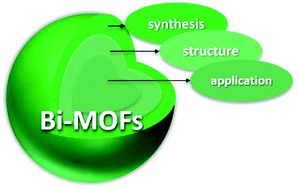Bi(iii) MOFs: syntheses, structures and applications
Abstract
Metal–organic frameworks (MOFs) are favored by researchers on account of their high surface area, high porosity, excellent structural stability and diverse structures, and have been widely used in catalysis, sensing, adsorption, proton conduction, etc. Although research of most MOFs has made amazing progress, the reports on Bi-based MOFs are limited. Nevertheless, because bismuth metal has a relatively large radius, is non-toxic and environmentally friendly, and has a high affinity for oxygen and nitrogen atoms, Bi(III) MOFs with varied structures and various properties have attracted considerable attention recently. Additionally, owing to the structural advantages of Bi(III)-based MOFs, more and more interest has been aroused in the design and preparation of such MOFs, especially in the application research. Nevertheless, as far as we know, no review has concluded the latest research progress of these MOFs. We believe that a comprehensive review of the recent preparation, structures and properties of such MOFs would be very helpful for further research. Therefore, this review will summarize the preparation strategies, crystal structures and a variety of applications of bismuth-containing MOFs reported in the past ten years and provides future perspectives.

- This article is part of the themed collection: 2021 Inorganic Chemistry Frontiers Review-type Articles


 Please wait while we load your content...
Please wait while we load your content...